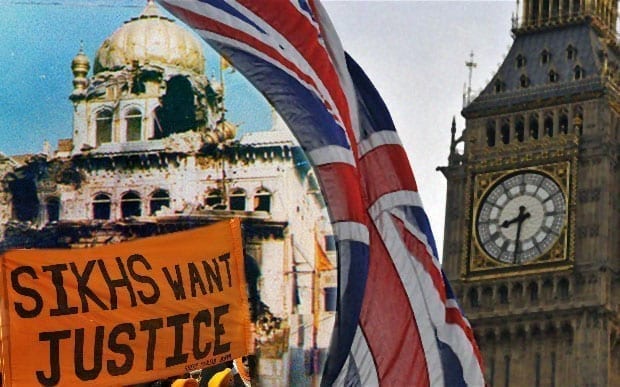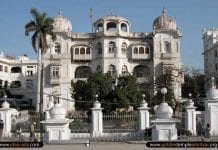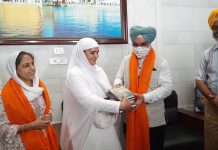Inquiry Report
The report starts with “The purpose of this report is not to investigate or pass judgement on those events, [Operation BlueStar]…” which is the first concern for some individuals. A lot of groups and individuals want the British Government to look into the events of Operation BlueStar and see if the attack on Sri Harmandir Sahib was justified. Now, I understand why the British Government would not want to look or pass judgement on another countries past operations, but many in the Sikh community feel that as our Government had a ‘limited role’ in the Operation they should look into the Operation BlueStar.
The third point clearly stated the remit of the inquiry
“To meet your remit I have looked at:
(i) why the UK Government agreed to a request from the Indian authorities to provide military advice on their contingency plans for operations at Sri Harmandir Sahib;
(ii) the nature of the UK assistance provided;
(iii) the impact of that assistance on the actual operation conducted by the Indian Army; and
(iv) whether Parliament was misled.”
The community felt this was too narrow as it was only looking at the events in June 1984 known as Operation BlueStar but the Operation, we know was pre-planned as in the desert a replica of Sri Harmandir Sahib was created and the Indian Army had been preparing different types of scenarios. There are unconfirmed reports saying the replica was made 6 months in advance of June 1984 and if this is true – was the SAS officer who visited India in February 1984 to advise on military options, aware of this.
Point 4 in the report give the number of documents and files that were looked at; “searched around 200 files (in excess of 23,000 documents) held by all relevant Departments covering the handling of events in Amritsar, from December 1983 (when the occupiers started to arm and fortify the complex), through to June 1984.” A concern here is that 23,000 documents have been looked at and yet only an extra 5 documents have come into the public domain. Personally, I understand the explanation of why but for an individual who doesn’t know procedure and the rules on what is/isn’t allowed to be released, this looks like an insufficient inquiry. (The last point, Point 24, states that “In line with the practice under successive governments we do not release information relating to the intelligence agencies or Special Forces.”)
Point 4 continues and says that “Some military files on various operations were destroyed in November 2009.” This was done under the 25 year rule at the MoD (Ministry of Defence) on the basis that the relevant officers (under the Labour government) felt that it was not necessary to preserve or release these files. Many in the community are asking why they felt this would not be of interest and whether there was anything contained in these documents that would have shed further on the events surrounding June 1984.
Point 6 highlights the visits by Indian officials and officers in the period of December 1983 to June 1984. It gives a summary of the purpose of the individuals and whether it impacted on the attack in Sri Harmandir Sahib.
Point 8 through to 11 examines the question “Why did the UK provide India with advice from a military expert?”
Point 8 says that the military advice was given as a “response to an urgent request from the Indian Intelligence Co-ordinator” and that the agreement to the request was “based on advice from the British High Commission that it would be good for the bilateral relationship, whereas refusal would not be understood by the Indian Prime Minister, Mrs Gandhi.” Lord Singh said on BBC News earlier that regardless of the advice from the High Commission why any advice was given to attack a place of God, a Gurdwara. Point 9 looks at whether there was consideration to offer training for such an attack. The files show that no training was given: “there is no evidence in the files that any Indian request was made, or that Ministerial permission was ever sought. Nor do officials interviewed recall any such request or offer.” Point 11 states: “The only UK request of the Indian Government, made after the visit, was for prior warning of any actual operation, so that UK authorities could make appropriate security arrangements in London. In the event, the UK received no warning from the Indian authorities of the launch of the operation.”
Point 12 to 14 examines the question “What was the nature of the military advice?” Point 13 states that the SAS officers report say that any military action should be a last resort. Point 14 explains that the SAS officers “advice given to the Indian authorities identified sufficient helicopters, and the capability to insert troops by helicopter, as critical requirements for this approach. The UK advice also focused on command and control arrangements, and night-time co-ordination of paramilitary with Indian Special Group forces. “
Point 15 to 20 examines “What was the impact of the UK advice?” Point 15 says “There is no record in the files of any formal or detailed military debrief from Indian to UK personnel, only references to the fact that one had not been received.” Point 16 explains that the UK High Commission in Delhi reported in February that a revised plan had been approved but it is unclear whether this new plan was revised on the advice given by the SAS officer or even if Mrs Gandhi has been the SAS officer’s advice. Point 18 highlights the differences between the advice and the attack, “analysis by current UK military staff confirms that there were significant differences between the actual June operation, and the advice from the UK military officer in February. In particular, the element of surprise was not at the heart of the operation. Nor was simultaneous helicopter insertion of assault forces to dominate critical areas. The paper on the operation made public by the Indian authorities on June 13th, 1984 makes clear that it was a ground assault, preceded by a warning, without a helicopter-borne element, which became a step-by-step clearance supported by armour and light artillery. “ Point 20 caused the most concern as it cites General Brar. General Brar has been accused of being a lead officer in the attack in Operation BlueStar and Operation Woodrose where many women were raped and many Sikhs were tortured and burned alive.
Point 21 and 22 examines, “Was Parliament misled on UK involvement?” It concludes that Parliament was not misled and that the “relevant papers on the UK military officer’s earlier visit in February, which was treated as Top Secret”
The report concludes is findings as:
“(i) the UK Government did send one military officer to provide military advice on Indian contingency plans for an operation at Sri Harmandir Sahib.
(ii) This military advice was a one-off. It was not sustained.
(iii) There was no other UK military assistance, such as training or equipment, to the Indians with Operation Blue Star.
(iv) The UK Government did not link the provision of this military advice to defence sales. The decision to help was taken in response to a request for advice from a country with which the UK had – and has – a close relationship.
(v) The military advice from the UK officer had limited impact in practice. The actual operation implemented by the Indian Army differed significantly from the approach suggested by the UK military officer. “
The last point, Point 24, states that “In line with the practice under successive governments we do not release information relating to the intelligence agencies or special forces.”
To be continued…





